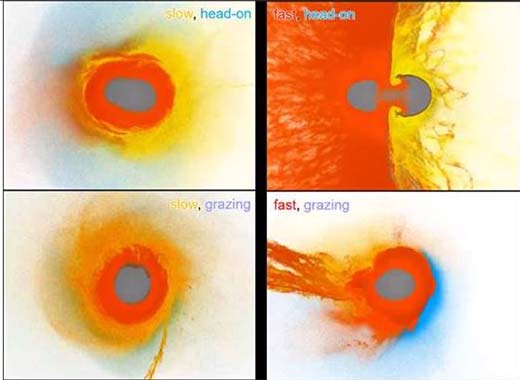Wednesday, 21 October 2020
 How Cosmic Collisions Can Change Worlds
How Cosmic Collisions Can Change Worlds
Speaker: Dr Jacob Kegerreis
Todmorden U3A was given a rare opportunity, at their October meeting, to Zoom into exciting new research by Dr Jacob Kegerreis of Durham University who offered us some of the latest insights into the role of giant planetary collisions in the history of our solar system.
Giant Impacts
Planets form hierarchically, starting with a small stuff that grows into the big stuff. Gravity causes everything in the universe to pull bits of itself towards each other if they are close enough. Soon, mountain sized planetesimals collide and crash into each other creating embryos the size of the moon or even Mars. Our Earth likely grew by five to ten protoplanets melding together to form the planet we have today. Neptune and Uranus, both gas giants, wreaked collision havoc as they changed their orbits dramatically in their early years before arriving in their current positions in our solar system. Jacob's research explores some of these giant impacts in more detail.
Simulations and Supercomputers
Jacob's day job is designing questions that supercomputers can help answer by creating massive simulations. Each simulation means solving problems – altered gravitational fields, how materials behave when the squashed and heated, how fluids behave when they splash against each other. All of these are expressed in equations and the computer solves them one by one.
Creating one giant impact simulation in enough detail requires trillions of calculations, so the key is to use a supercomputer (thousands of computers) to perform multiple calculations efficiently. Jacob showed us amazing time lapse visuals of their experiments, modelling all stages of a collision.

Was Uranus a pushover?
Uranus is an ice giant, mostly ice down to a thick rock centre, a lot of water ice but also methane ice, and ammonia ice mixed in as well. The strange thing is that Uranus spins on its side. Most planets spin upright, albeit slightly tilted. Could Uranus have been knocked over?
Jacob's task was to calculate whether or not one or more impacts could achieve this sort of change in the planet. His experiments went on to investigate what else happens to a planet when you hit it with something big – for example, changes in the temperature, magnetic fields and the atmosphere.
A 100,000,000 particle simulation of an impact on Uranus
After hitting Uranus from different angles, he found that the more grazing the impact the faster the planet would spin, and perhaps only two or three Earth-sized impactors may have produced enough spin to change the orientation of the planet.
Even such small grazes were cataclysmic and Jacob enjoyed showing us some awesome images. Modelling with up to 10 million particles, colouring effects were used to show in extraordinary detail, changes in the planetary core as well as the ejected debris trails that eventually looped back to the centre of gravity again.
Atmospheres on distant planets
Exoplanets are found around other stars in our galaxy. In recent years, thousands of them have been discovered, many of them with sizes between super-Earths and mini Neptunes. Some have thick atmospheres, some of them none, and everything in between. What gives rise to this diversity of atmospheres around exoplanets? In a final flourish, Jacob showed us some of his experimental results studying how giant impacts can produce a complete range of final atmospheres around planets.

In the four pictures above we see the effects of grazing, head-on, slow and fast impacts on the atmosphere. Over 300 different scenarios were worked with - the angles and speed were changed to see what different effects occurred.
Jacob is an enthusiastic and visionary young astrophysicist, destined for higher things. He also proved himself a skilled and knowledgeable presenter through this stimulating, challenging and memorable talk from the cutting edge of current astrophysics research. The cleverly designed narrative ensured that members experienced a helter skelter ride on a cosmic scale, in their own homes.
A much more detailed account of the talk with extensive illustrations appears on our website.
The next Todmorden U3A Monthly Members Meeting by Zoom will be on Thursday November19th at 1.45 p.m., open to all fully paid up members for 2020. Our presenter, Steve Ward, will entertain and inform us with "The Life and Times of Philip Astley, known as Billy Buttons, Father of the Modern Circus".
Not yet a member? You can attend one talk free by requesting an invitation to this zoom event. We're always delighted to welcome new members.
Our contact details are www.u3atod.org.uk (website), info@u3atod.org.uk (email), or 01422 886021 (phone).
Many thanks to Michael Astrop for this report
Previous U3A reports on the HebWeb - click here

